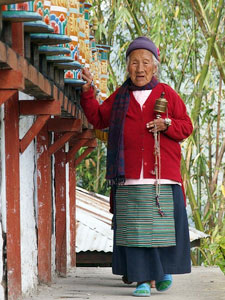|
|
|
Symbols of Sikkim |
|
|
|
Images and Symbols of Sikkim |
|
Monasteries and many buildings in Sikkim
are richly decorated with symbols and icons. These symbols are
painted or embossed on the walls or on Thankas. These paintings
may depict the life of Buddha or some Tibetan saint, the Wheel
of of Life or a deity surrounded by lesser deities. |
|
|
|
Wheel of Life
The Wheel of life is one of the purest Buddhist emblems.
This emblem can be seen in the entrance of almost all
the monasteries. This emblem is also widely depicted on
Thankas or religious scrolls. The circular form of this
wheel symbolizes the ceaseless worldly existence. This
wheel is held in the clutches of a monster with its
claws and teeth and signifies the passionate clinging of
the people to exist in this world. The hub of the wheel
contains a cock, a snake and a pig. The cock signifies
lust or desire, The snake signifies anger and the pig
symbolizes ignorance and stupidity. These are shown in
the center of the wheel as it is said that they are the
root cause of the trouble on earth. In the intermediate
circle of the wheel of life, the five worlds are drawn
as advised by Lord Buddha. The ring between the
intermediate world and the inner most circle of
ignorance, lust and envy is drawn in half white and half
black. White area symbolizes good deeds and Black
symbolizes bad or evil deeds. People going upwards in
White portion represent people who have performed good
deeds in their lifetime and are now going to take
rebirth in |
 |
|
|
the world of
gods. People going in the Black portion indicate hell or the
world of animals. In the intermediate circle there are five
parts that of which the two upper parts symbolize heavenly and
human worlds. The remaining three worlds in the lower path
symbolize sinful deeds leading to a world of animals, ghosts
and hell. Outermost circle shows twelve phases of life.
|
|
|
|
Eight lucky signs and their significance
The eight signs are called as Tashi Tegye in Tibetan. One can
see these signs among Bhutanese art. These auspicious signs
are intimate with life and teachings of Buddha. These eight
lucky signs manifest themselves in paintings and in the form
of carvings on furniture and can also be seen on the walls of
buildings. These eight lucky signs are as follows:
1. The Dug (Parasol)
The Parasol of authority symbolizes the authority of Buddha.
The Parasol protects the head from the scorching heat of Sun
just as the law protects the mind from the scorching passion.
2. The Bhumpa (Vase)
The Vase represents a repository of limitless material wealth,
good health and long life.
3. The Conch Shell (Dhungkar)
The Conch Shell symbolizes reverberating sound of Dharma and
signifies the awakening of sentinent beings from the sleeping
state of their ignorance. It persuades them towards the path
of noble deeds that are beneficial to others. Gautam blew the
conch shell when he decided to preach the law. The Conch shell
is blown in commemoration of this event whenever there is a
special sermon by a high lama.
4. The Banner of Victory (Gyaltsen)
The Banner of Victory signifies the fortune of having victory
of good over the evil forces which hinders the success of
noble goals and also proclaims the victory of piety over evil.
It is used in processions.
5. A Pair of Golden Fishes (Sernya)
A Pair of Golden Fishes symbolizes resurrection of eternal
life, rebirth etc. The pair signifies the ability to swim with
ease without obstruction in the ocean of this world. They may
also be taken to symbolize the eye of perception as fish can
see through muddy water. The fish couple suggests mutual aid
and indispensability between male and female material life.
6. The Lotus Flower (Pema)
The Lotus Flower symbolizes the ultimate goal namely
enlightenment. As the Lotus comes out of dirt but does not
carry any dirt similarly law is free of all earthly matters.
7. Knot of Eternity (Palbheu)
The Knot of Eternity is a law without beginning and without
end which symbolizes Eternity. The curly hair on the chest of
Buddha has the appearance of Knot Eternity. It is also called
as lucky net and symbolizes Brahamajala representing all the
theories and philosophies of the universe.
8. The Wheel of Dharma (Choekyi Khorlo)
The Wheel of Dharma symbolizes the propagation of Buddha's
teaching. The first sermon setting in motion of the cycle of
law is symbolized in a wheel with eight spokes, which stands
for the eight fold path. |
|